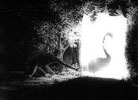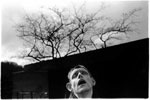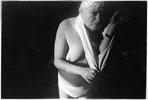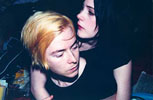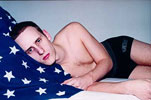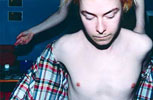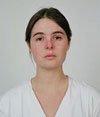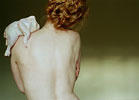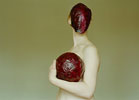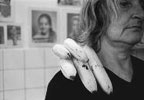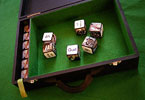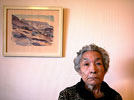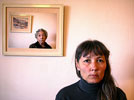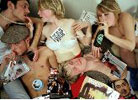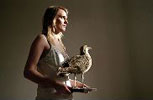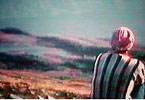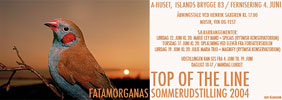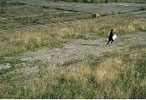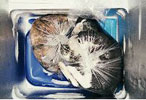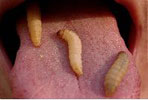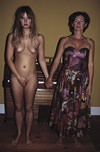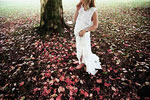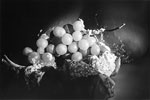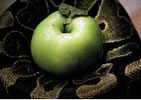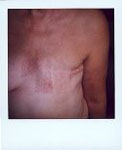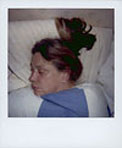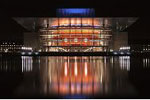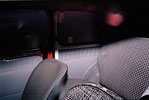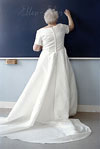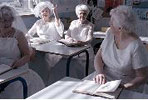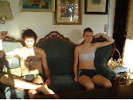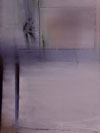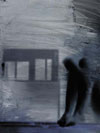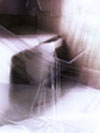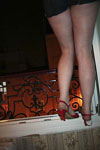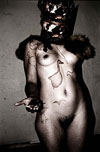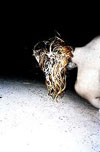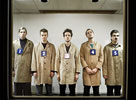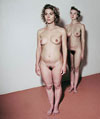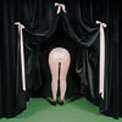FATA
TIME &
SPIRIT
The History of the Art of Fatamorgana 1999-2007

Bubbling with
imagination
imagination
The creative juices were flowing,
the neighbors were annoying, and
the residents’ association was full of prejudice.
Peter Bengtsen de-robed in an image, and crawled on all fours towards a glowing godly swan, visualizing the yearning for the unique, the wonderful, and unattainable.
Frederik Fennsbo did the opposite. He brought his whole family to Ikea, where he in a living room setting, with price tags on all the inventory and a tone of an undertakers storefront window, visualized the culture depraved masses’ lack of fantasy.
Frederik Fennsbo did the opposite. He brought his whole family to Ikea, where he in a living room setting, with price tags on all the inventory and a tone of an undertakers storefront window, visualized the culture depraved masses’ lack of fantasy.
One was just as enchantedly idealistic, as the other was pragmaticly realistic, but both images were unique, personal messages about doing something with life, as long as we have it.
The culture
depraved masses’
lack of fantasy
The creative juices were flowing, the neighbors were annoying, and the residents’ association was full of prejudice. We had to go.
The year was 1999, and the schools first computer, a scanner and printer took up space in the schools small library, one of the three rooms we had in our small apartment in Teglgårdsstræde.
There was not enough room for another computer, unless we closed down the darkroom and film development room, and I could not do that as long as they were still being used.
We were entering a technological transition period that demanded both a conventional, as well as a digital darkroom. You either did the darkroom, making black and white images, or you went to the mini lab with your film and got a bag of color negatives, which you could scan and print out in the library afterwards.
We had to find a new place.
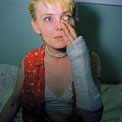
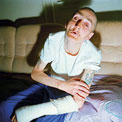
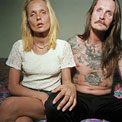

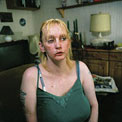
Ditte Haarlev’s series of AIDS-infected drug addicts crossed boundaries.
Through an obliging caseworker she had gotten in touch with several unhappy existences, who had lost both hope and dignity and instead of photographing with respect and empathy, she exhibited their misery: Like animals on their way to being butchered, in-humanizing and debasing. The series was challengingly different, boundary-crossing to such a degree, that the caseworker who had facilitated the contact, demanded the images be removed on the shows first day, even though the drug addicts themselves had nothing against them.
The ugly snapshot aesthetic, the lost dignity, and the boundary-crossing disrespect of the times had challenged the system and the classical documentary ethic.
One was allowed to do more in a snapshot, and one did.
Seeking out the sensational and portraying it sensationally, letting go of one’s inhibitions and taking part in the festivities.
It was not about
taking a particular stand,
but about letting go
Martin Zakora went to drag parties and photographed, with a nonchalant matter of course, what he saw. There was no professional distance, no ethical or aesthetical considerations. He created tight cheeky fragments as though the eye was a lens and the blood alcohol content a little high.

It was not about taking a particular stand, but about letting go. The snapshot wave had with the help of technology lead us into a turbulent time, where rules were broken and taboos transgressed. Honey Biba Beckerly was admitted as a student because she among a bunch of bad sultry erotic images had photographed a red rubber glove and a banana. It was an impulsive image, thoughtless, anarchistic, and visually brilliant. At Fatamorgana she became like a fish in water:
She swam.
She went to sex clubs and tattoo parlors and romped in uninhibited image bliss.


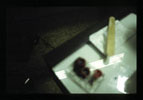
An impulsive image,
thoughtless, anarchistic,
and visually brilliant
Martin Zakora also gave himself free reign, but when he was feeling both sensible and ordinary, he had to go to a drag party to get in the right mood.
When he presented the images, we were not in doubt about the fact that he could not have been just a photographer at these parties, but also a participant. The images were stumblingly slanted, cheekily uninhibited snapshots. He was commended for having completely engaged in the environment he was depicting and he had had a blast doing it.
It was easy for some people to let loose, others had to fight hard. Charlotte Hjorth-Rhode had a husband and kids and a villa and came from a job as head designer in a fashion company, so, throwing off her panties and documenting her own crotch was not easy, but she did it. Not as a snapshot with a flash and strong colors, but as a diffuse and dreamy black and white image, in which she played the role of a corpse.
The most beautiful,
most aesthetic and loving portrait,
that was ever made
at the school.
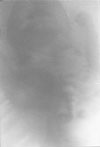

And she took the clothes off her boys, and made the most beautiful, most aesthetic and loving portrait, that was ever made at the school.
Never had intimacy been so intense. It was boundary breaking, but not in the same way as the provoking anarchism that dominated. Freedom for Charlotte was not about stumbling and thoughtlessness, but rather about intense honesty.
But she did try it, the liberation, the provocation and disrespect. She poured spaghetti over her head and flirted liberal eroticism with a black male cat.

That was the first and only time that Charlotte was wooed by the times turbulent tornado. Since then, she has worked solely in black and white and only made sensitive images: Decent images filled with love.
No, the photographic confession was not for Charlotte, but it was something for Katrine Dollerup.
Not to show,
but to be
but to be



The confessions were not directed towards anyone, but rather towards herself.
The snapshot as a “to-do list” became a genre: Unaesthetic, private flash glimpses, notes on what happened, and needs to be remembered. Confessions and recognitions:
This is what I look like, I recognize myself. I recognize who I am and I accept it.
Several years later Katrine asked me to remove the most intimate of these confessions from the schools website. She had a husband and a child, and the art had moved.
The end of our time in Teglgårdsstræde was characterized by the coming change.
Pelle Rink stood in the black and white darkroom making black-bordered humanitarian documentary images. It was his thesis on societies outcasts, on mentally handicapped living in an institution.
He was the last of the classic photojournalists,
she was the first snapshot documentarist
He wanted to show what he was capable of, she wanted to show, who she was. He was the last of the classic photojournalists, she was the first snapshot documentarist.
He cultivated a genre, she created a new one, he had the hinterland in order, and her future lay ahead.
In our last exhibit in “Pisserenden”, just around the corner at Galleri Krebsen, she spread her impulsive, skewed, experienced, energetic, expansive and playful images on one of the end walls. And because Politiken had brought a two-page spread with the images she was exhibiting of teenagers at the disco Inn, dancing “high” on soda on a Sunday morning, there was, for once, a whole lot of visitors. TV-Lorry also wanted to be a part of the scene, the press had smelled the good story, and understood that something big was on the way. The new wave had media pull power, they liked the new breakneck paced trend, it was young and fresh and bubbly.
A week later we moved.
Since October I had been holding painting weekends with old students at the new space. Carpeting had been laid down upstairs, and darkrooms had been built in the basement. The space was big, and impressive. A football club had moved on to new quarters, and we moved into a real klondyke of an area, along with car mechanic shops, company headquarters, and private psychiatric counselors.
There was room, lots of room: Room for computers, and cars, for parties, and the fragrance of chemicals. I foresaw serious communication problems in such a big space, with two floors, so I installed an internal communication system. That way I could always reach the students and vice versa, but no one learned to use it so I took it down after a year of non-use.
My notion that everything would continue on as it had been, and that the only difference was that now there was more room, proved itself to be wrong. 30 students in 400 square meters on two floors, was something completely different than 20 students in a two-room apartment. Fatamorgana had grown out of its playpen, and become an institution.
New routines happened, as well as new needs, and new problems. Seriousness spread, discipline was toughened, responsibility moved, and the demands rose, but the art was unaffected. The art and the spirit remained the same.
The physical conditions had changed, but the students and their images did not. The language was the same, the confessional wave continued as if nothing had happened.
The confessions were not
directed towards anyone,
but rather towards herself
Rasmus Rosenkjær took pictures of his experiences under a hospital stay and Anna Strand took her camera with her to a party with her friends.
These were personal, intimate images in possessing intimacy and spirit. Not high party spirits as when Martin went all out to a drag party, but rather images revealing heavy and moody, almost apathetic conditions of empty existences: Strange, cold, colored depression. Powerlessness and youth became a new constellation. They both applied to the desirable Högskolan för Fotografi och Film, at Gothenburg University and were accepted.
It gave the photographer power and self-confidence to get one’s models to falter.
But not everyone was as open about their own condition as Rasmus, or as openhearted as Anna. When Dagmar Atladöttir presented her confessional project for a crit, a personal diary, there were several pages that were glued together because the content was so private she did not want to show it.
Secrecy and confessional strategies don’t go well hand in hand and the snapshot genre shifted imperceptibly from being self-exposing to being about exposing one’s subjects. People revealed themselves when the camera was aimed at them for such an extended period of time, before pressing the shutter button, that it became embarrassing.
The camera became a weapon and the subjects were de-robed. Not literally though. The bold ideas and daring acts of de-robing had become childlike provocations. Now, the embarrassing moment, where the smile for the camera faltered and bared insecurities, revealed the truth itself.
An internal sincerity emerged when the mask fell and the face surrendered itself.
The discomforting portrait could not compete with a busy background, so the preference was a white wall. An empty, white, neutral surface so there was plenty of room for the helpless staring gaze.
It gave the photographer
power and self-confidence
to get one’s models
to falter
Hilde Osen found a toilet with white tiles and a girl with her heart on her breast at Fisketorvet.
The staged portraits had a magical radiance of uneasiness. The missing self-confidence, which most of the students possessed, was recreated in the subject’s faces.
It gave the photographer power and confidence to get one’s models to falter.
The embarrassing moment,
where the smile for the camera
faltered and bared insecurities,
revealed the truth itself
One day I was shown a contact sheet with nothing but boring, semi-depressing portraits and asked what I thought. My disappointment at being confronted with nothing more than sleepy indifference, was just as great, as the effort of taking the images must have been. Each exposure had been taken after the photographer and the model had stared steadily into each other’s eyes for twenty minutes.
The idea was that this torturous, tense intimacy would open up for a deeper lying acknowledgement. The meditative portrait.
I could understand, from what I was told, that both the photographer and the sitter had had a moving experience, and I could see, when the images were printed up in a large format, that there, in those blank eyes, lay a seed of something different.
The possibilities for variation in these revealing portraits were soon depleted, but long after that wave had reached its crest, there were students who with academic cunning and creative invention created new versions of the intense portrait.
Titika Rotkjær coaxed Kirstine, Rebekka, and Thora to rub their eyes with onion to create the effect of insufficient self-tragedy.
Staging took over the depression, sincerity was lost, intimacy was postulated, and after a while, everyone also thought it was much more fun to make things up.
Best at it was Therese Boisen Haas.
She could come up with things, she could stage, and she loved to do it.
Her warm laughter reverberated through her inventive self-portraits, where she either placed a defrosted chicken on her shoulder, had a herring hanging down from the ceiling, or a prosthetic arm on her shoulder.
Her warm laughter reverberated through her inventive self-portraits, where she either placed a defrosted chicken on her shoulder, had a herring hanging down from the ceiling, or a prosthetic arm on her shoulder.

She could come up with
things, she could stage,
and she loved to do it
She seduced us, we felt entertained and we had fun. She flirted and acted and made things up, and there was always a unique twist in her images. We knew she was enticing us with her forms and her fantasy, but we let her do it.
Manipulation had once again re-found a positive tone.
It was allowed to be entertaining, and the inventiveness was elaborate.

Gry Friis Jørgensen placed herself in the middle of the dividing island on the motorway, and having placed the camera on a tripod, she pressed the self-release shutter ball.
Thepoint of it was,
that it was pointless
that it was pointless
It is a part of the entertainment value that she is alone, positions herself, and that she is the one that decides the moment.
One should not look for deeper motives, there is no confession, or symbolism, or mystique at play, only attention demanding entertainment.
We are to wonder and react, to awaken and to become inspired.
The point of it was, that it was pointless.
The “make it up” images were like powerful fireworks that were sparked without anyone quite knowing how big of a bang they would make, and no one knew what kind of effect it would have.
The gunpowder was packed in, the fuse lit, and then one would just run for cover.
Kirstine Lundøe Gyldholm made a fire in a marsh. Dry, withered rushes, and an old garden chair light up in the night, and the image demanded our attention.
It was different, spectacular, and entertaining. And it was an amusing idea, both to come up with and to behold.
The “make it up” images were like powerful fireworks that were sparked without anyone quite knowing how big of a bang they would make, and no one knew what kind of effect it would have.
The gunpowder was packed in, the fuse lit, and then one would just run for cover.
Pernille Paungreen photographed her grandmother with bananas on her shoulder, not because it had some deeper meaning, but because it got one’s fantasy going. Her grandchildren’s snapshots hung on the wall behind, and she had bananas on her shoulder. Why not?
Anybody’s interpretation was legit, and if one only experienced a healthy chuckle, that was ok too.
But it was completely impossible if you thought that the artist had a hidden agenda, or that the image hid a secret message for the initiated. The point of it was, that it was pointless.
The Directors flowered, creativity unfolded, and inventiveness competed to attract the most attention. It was fun to fabricate, but boring to photograph.
It was an amusing idea,
both to come up with
and to behold.
The attention grabbing aspect and the entertainment value were still integral to the image, but the work of art was no longer the image one had photographed, but rather, the performance it documented.
Nan Na Hvass always walked around with a smile on her lips, as though she was contemplating a secret surprise. And she was filled with surprises, and she could come up with ideas, and she could seduce, and she could carry them out.
Like the time she went to bed with a dinosaur. An ugly green plastic figure, who attempted seduction, like a greedy lover at bedtime. He ended up falling asleep on the pillow beside Nan Na herself, who seemed completely unfazed by the occurrence.


She documented the séance herself, with the camera at arms length, as she played the role of the sleeping innocent.
It was also Nan Na who attempted a dive at home in her apartment.
One wall was wallpapered with a grand view out over the sea, and typical for her, Nan Na came up with the idea of using it in a performance.
A satirical and erotic happening with charm and bite. We are amused and seduced.
The work of art was no longer
the image one had photographed,
but rather,
the performance it documented
For her individual assignment, “You must not use the Lord’s name in vain”, she created a clever dice game with Christian words and images instead of pips.
When you rolled the dice, you could end up with words that together would form sentences like “Oh my goodness”, or “Oh lord, protect us”.
It was obvious that randomness created the sentences and that one should not give it greater meaning, yet it was still a surprise that the sentences were meaningful, as though chance in this instance was intelligent and spoke to us in a divine manner.
It was an outstanding idea, the design was consistent, and the piece was accepted for Charlottenborg’s Spring Exhibition. In a well-fashioned handmade box, the dice were presented in a display case. The surprise of the game’s randomness did not translate through the glass, but that something meaningful was hidden in the magical cubes, was obvious to everyone.
Photography had lost its monopoly at the school: The ideal became to create art, not to create photography. For an end of semester exhibition at Cafe Krasnapolsky, Jacob Vinamata Jessen had created the project Airline. He showed up in a pilot’s uniform and was a part of his piece, which otherwise consisted of inventory of the fictive airline company’s office. There was merchandise with the company’s logo, airplane posters on the wall, a calendar and a timetable.
The installation rendered the photograph unnecessary.
When the possibility for showing the actual performance was available, there was no reason to document it photographically and exhibit the images.
So when Espen Gleditsch created an artwork that in eight steps demonstrated a hamburgers development through a couple of weeks at room temperature, it would not have had the same effect as if the piece was merely photographed. The scent was a part of the piece.
The developing mould could be photographed, but the stench only stuck to the original.
The ideal was to make art,
not photography
not photography
But when he created the piece, The Left Sock, which was comprised of a drying line strung up in one of the classrooms, with lonely socks stolen from different Laundromats around town. He also had an accompanying catalogue, in which each sock was depicted. In that instance, the photograph could be used.
The ideal was to make art, not photography.
To be a photographer was not an ideal, and to photograph was no big deal.
I was provoked by Espen’s undisguised negligence of the meaning of photography and it’s role. He worked on a project he titled Black Holes, and being provoked by his scientific theortical attitude, and his missing photographic vision, I blurted out:
- No! You are not a scientist, not at all!!! To which he snapped back:
- What makes you think that I am not?
To be a photographer was not an ideal,
and to photograph was no big deal
Joen Vedel Pedersen visited a spiritualist, went to a logic conference, and was just as much a scientist, as he was an artist. He thought out his projects and documented what happened. He was not a good photographer, but he was a supreme thinker.
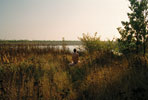
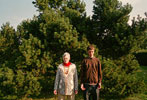


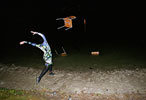

Like when he ran through a field with a satellite dish as tall as a person, or placed one of his friends under a blue sky to ponder a blue image.
He photographed the nerds as they pondered in a circle, and himself meditating at sunrise.
He photographed the nerds as they pondered in a circle, and himself meditating at sunrise.
We had to imagine what they were thinking about when taking these images, but there was no doubt in our minds, that their thoughts were grand and meaningful.
Joen got into the The Royal Danish Academy of Art that year, as did Thomas Bo Østergaard the year after.
During one of Thomas’s first critiques I thundered on about his wasteful and awful images. He had been given the assignment on the demolish threatened The Youth House on Jagtvej. He had been to Faderhuset next door and attended mass. The independent religious community, Faderhuset, had bought The Youth House and were just waiting for the youth to be thrown out of their house. But instead of seeing what was going on, we looked directly into the necks of the people that stood in front of him.
- You need to go closer, what were you doing back there?
- I was recording.
He had made sound recordings of the ceremony with his mobile phone. Fantastic, mood infused sounds of the parishioners praying in chorus about salvation. A rattling scraping noise as if from a radio station made the whole thing as authentic and exciting as spy recordings from the underworld.
He then received another scolding for having shown the lousy photos and not having played the fantastic sound.
- When you one day realize how talented you are, you will be good, I preached, really good!
When he applied to The Royal Danish Academy of Art, it was partly with toothpick models of larger installations, a couple of the flat rectangulars, and two tape recorders with each their soundscape, one of them with Faderhuset’s scraping invocation of God.
Where Thomas was bumbling and intuitive, Per Juul Poulsen was confident and invincible. Goal oriented and methodical, he worked on founding and running a fictive telegram agency. The first crit was a company board of directors meeting.
One of the classrooms was set up as a meeting room, where everything was readied for the fictive meeting. There were filodex cards and brochures for utopian inventions from the 1930’s. There was water and coffee and the company’s newest product, the bulletproof telegram.
The following months we all followed the company’s development with anticipation, and Per’s perseverance and mental gymnastics lead us through the many phases of the winding labyrinth of the world of communications.
His visual efforts at absurd solutions were entertaining and humorous.
Performance was
the defining element
the defining element
And it was infectious. That period of time was full of creative inventions, where performance was the defining element and photography a tool for documentation.
Often the photographer starred in the performance, like the time Camilla Josefine Stephan took a self-portrait sitting in front of a portrait of her mother, who is sitting in front of a portrait of her mother, who is sitting in front of a painting, a watercolor of a Greenlandic landscape.
A visual family history, that in the course of three generations, had wiped out her grandmothers characteristic Eskimo features. A performance created through the help of fantasy and photoshop.
Jonathan Grevsen’s one act, where a young naked latino man with the Danish flag as a backdrop takes his pill, was real. Documented staging.
Jonathan Grevsen’s one act, where a young naked latino man with the Danish flag as a backdrop takes his pill, was real. Documented staging.

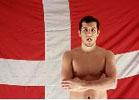
Felipe was a Chilean refugee who grew up in Sweden, but who was temporarily in Denmark to attend photo school. What the contents of his pill were, or why he took it, we never found out, but it was obvious that there was something both important and dangerous going on.
Was he taking the pill to become Danish more quickly? Or was he taking it to endure his time among danes?
Camilla’s performance was educational and solemn, whilst Jonathan’s was inspiring and humorous. We were forced to imagine around each of their performances.
Joachim Adrian Mikkelsen was also amusing in his exuberant, self-ironic, grotesque, bordering on the vulgar tableaus. It started during the week Laura Eriksen was the guest teacher. He had a girl basking on white sheets with a bloody herring in her lace panties. The image has since been the opening image on his website and defined its name; www. fotosild.dk
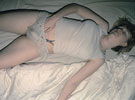

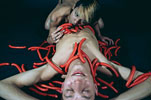
After that came the image of the boys taking a bath in a tub of cornflakes, and the guy on all fours eating red Bavarian hotdogs off his loverboy’s bare belly.
But the masterpiece of them all was the decadently satirical and grotesque performance where the young people, with beers in hand and bras half off, slam the events surrounding September 11th, the terror scare, and how the press was agitating the war atmosphere.
We were forced to imagine around
each of their performances
Joachim did not only have something on his heart, he also had the courage to express it. It was not good tone at that time to parody the youths apolitical egoism, their pseudo-decadent greed and brain dead weariness. To make jokes about the twin towers collapse six months earlier was unheard of. And unprecedented. There was no mistaking the message of “WE’re AT WAR”. Stuffed into an A-cup, it was entertaining satire, a performance with a distinct point of view.
You were not to be entertained,
but to feel embarrassed
but to feel embarrassed
At this time it became more and more customary to use video as a tool to record these performances instead of documenting them with photography.
Mie Riis Christiansen solved the assignment “The Death in You” with her mobile phone. A simple, poetic tale, with washing blowing in the wind, flounce, and her grandmother’s wrinkled hands, a light bulb being switched on and off, and a door being closed.
A short and beautiful video, that had but one problem, it was taken in portrait format, so to view this heartfelt sigh, we had to lay the computer on it’s side.
Another noteworthy video was the result of five students frustration with an impossible assignment.
They had each been given different letters to the editor from the local newspaper and were to delve into, give their imagination free reign, or just plain relate to the subject matter of the letter. In their desperation in regards to what they perceived of as an impossible assignment, they chose instead to record, with the moving image, what they were doing to pass the time whilst plagued by their performance anxiety.
Mette Kaj procrastinated by doing housewifely chores, such as ironing socks and cleaning the kitchen until the stove gleamed. Benjamin Kürstein passed the time on the divan with the stereo turned up, the tv on, and a lit cigarette in his mouth. Jesper Brantefors recorded what he saw whilst sitting on the toilet, Eva Marie Rødbro danced around in the dark, and Alette Schei Rørvik talked to her mom on the phone off camera, while we from a birds-eye view looked down on an abandoned game of solitaire on her kitchen table.
The video was a document of the times, filled with self-reflection and humor and much more than just a commentary on a letter to the editor.
To make video, when one is used to working with still images, is like creating a new language. This language was not something the students were learning, but creating.
Nan Na Hvass had for a long time had an image in her head that she wanted to create. A memory from childhood, that she could not let go of. It was an image of her father, who at bedtime used to meticulously peel an orange for her and her mother. She managed to convince her now graying father to repeat the feat for the camera, and thus the one-shot video was invented.
A loooooong shot, of the same uneventful motif, as if taken from a surveillance camera after closing hours. There was no drama, no story line, no bombs, nothing, just her father cutting fruit.
The protaganist in Michala Paludan Nautrup-Hansen’s one shot video was definitely more attention-grabbing. She had been riding around with a pig head on her bicycle’s luggage rack to take dramatic, grotesque, and inventive images of Charley’s amputated head placed in strategic places where it created situations that either were entertaining, ludicrous, or provoking.
She had been given the pig’s head in connection with an individual assignment, and as the days went by, it began to smell stronger and stronger, and she was not satisfied with any of the pictures she was taking. They were all just plain silly.
Then she decided to make a video.
A video where nothing happens. Just a loooooong shot of her and the pig’s head beside each other on a small couch as time ticks away.
Those two videos, Michala’s with Charley, and Nan Na’s with her dad opened the door to a new period, where the image did not offer itself up for interpretation, but it became an authority. It’s purpose was not to entertain, but to embarrass the viewer.
The image was not trying to help you understand, but rather to obey. Of course you could ask questions, but you would not receive answers.
Why does it exist, why is it taking place? Because it just does, and is. Why should I have to sit here and watch it when nothing is happening? Because you must.
It hit me towards the end of her pig’s head video, that this was exactly what Michala had been trying to do in her photography for a long time: To make obviously indisputable images of the act of obeying a personification of thoughtless acceptance.
Lotte Fløe Christensen went to Råbjerg Mile to find eternity. There was sand as far as the eye could see, and there was Lotte turning the world upside down.
Kirstine Autzen had earlier, on a course with Søren Lose at Krabbesholm Højskole made a series with stuffed birds.
Now she gave one of them to a woman to hold in her hands, and she placed her alone in a room with a look on her face as if she had no clue as to what she was actually doing there.
It seems insignificant, and it is insignificant. The woman obeys and accepts, and I react.
I yell to her as if I might be able to free her from the sectarians and the saved that have managed to brainwash her.
- Do something! But she remains frozen, as if caught by unseen forces.
Julie Salvesen had found and old photo of her mother where she is sitting enjoying a glorious view on a hiking trip in the Norwegian mountains.
The image resonated with eternity, and to accentuate the feeling, she filmed the fading image, and then re-photographed it on a television screen. There was not much meaning left, not much information or enjoyment that came through in the final image. What it communicated was authority. The image was indisputable, you were to believe in it, not understand it.
But Kristina Bengtsson was different, her eternity was about freezing time.
To believe
not to understand
not to understand
A liter of milk flying in midair was inconceivable, and absurd, and if one did not believe it had happened, it was inconsequential. But one did believe because the image emanated authority.
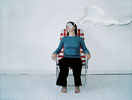
It was obvious that it could not be any other way. Even if no one had ever before seen such a godly vision, one knew, that it did exist. It was truth itself.
Markus Öhrn was probably the one who started the icon wave, but at that time I had no idea of where it would lead. Markus was thrifty, thoughtful, and stubborn.
The first four months his motif was the same lonely tree in a windblown field. A lonely disheveled growth in the middle of the wilderness, left alone to fend against the wind and weather, and the game of coincidence. Nobody gave it any value, or even noticed it, but it was there.
Slowly he allowed other elements to enter his photographs, but the expression was always the same. He was never coaxed into discussion or pleasure. His ambition was to express his character and personality.
After four months of lonely trees he photographed his mother in a hotel room. A lonely tousled woman in a slip on a strange bed, in strange country. Nobody counted her for anything, she was without value, and without meaning, but she was there. It was a fantastic, strong, and personal image.
My assumption that the lonely tress had been a kind of self-portrait was wrong. Markus was not self-absorbed, the trees were his mother.
After another semester at Fatamorgana he applied to Kunstfach in Stockholm with a series of well thought through everyday situations that he had staged.
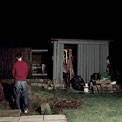

Disheveled destines, shaped by coincidences game, placed in the middle of nowhere. What they are doing has no consequence, it is incomprehensible and indifferent, it holds no value. Even though no one deemed them of any value, they were there.
The images emanated authority, they spoke the truth. The sacred truth about being human, we were not in doubt about the fact that his images communicated, nor were they at Kunstfach. Nor were they at Charlottenborg when they chose his images for Forårsudstillingen, their juried spring exhibition.
That is how it is to be human.
We are placed,
we accept our situation,
and then it’s just about passing the time
Lotte Fløe Christensen kept on working with the project “the world upside down”. She convinced her friends to hide in the trees, to blend into the hedge, or to run off from it all as in the image of the woman in the distance with the white suitcase.
The documentarians that hurried from one event to another and photographed stumblingly and impulsively gained a little more calmness in motor functions. They breathed in the emanating aroma of eternity, and held back on the bait. They surrendered to the prolonged image.
Like when Anders Birch photographed in a families home in Søllerød. For weeks he walked back and forth between the authentic carpets and the swimming pool to capture decisive moments that lived up to the golden rules of good reportage.
But eternity rubbed off and in his beautifully completed book about the family, the main image absurd.
An image of the families youngest son lying on the floor in the hallway right in front of the garden door, his reclined position turning the world upside down.
It had been a long time since a student was praised on the first day at Journalisthøjskolen as he was for his Søllerød book.
His faithfulness had paid off by giving the images authority and the book stature.
Ullla Marie Aude was young, quick and positive. She had a hard time with the slow image, was way too restless for the thoughtful and unexciting, but loved when she was surrounded by foolishness.
When she could have a good laugh, her images were filled with energy. In the water amusement park Lalandia this was possible. Better than anyone at finding and capturing falsity, she bossed the men around and pretended she was impressed.
One needed unfailing courage,
a naive self-assurance,
and the ability to always find a shortcut
She also went to the vet and pretended she pitied both the poor pets that had gotten something in their eye, as well as their unfortunate teenage moms.
It was liberating to laugh with Ulla. She was generous, easily given to laughter, uncomplicated and welcoming, and she could see too.
She stuck her head into a freezer chest and saw there were goodies there for the laugh muscles.
The expressive, immediately understandable image, with simplicity and power, spread. Expressive motifs were found, or created, and the dividing line between the documentary and the staged photograph became obliterated. One could move from one expression to the other without anyone noticing. There was no problem combining situations one had found with situations one had arranged, as long as it was fun to do. And fun they had, the expressive ones, always on the go searching for something to articulate.
Trine Chrzan Olsen, froze up when she was given the assignment of making alternative postcards of Copenhagen. A fictitious assignment that challenged the imagination, and that encouraged her to unite the professional, with the expressive, she did not end up solving the assignment successfully. She had a hard time imagining a postcard as anything other than a boring image of a tourist attraction.
As soon as the assignment was over, she scattered expressive postcards around her. She went all out and the tourists would have loved it.
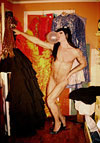
She documented and staged and gave it her all. He was not only nude, the drag queen dressed solely in a wig, he was blowing bubble gum and discreetly eliminating his manhood, whilst dancing for Trine in his wardrobe.
Yes, it sure was fun to be expressive.
One needed unfailing courage, a naive self-assurance, and the ability to always find a shortcut.
As with Julie Breuning when she wanted to tell how she was feeling. Others may have come to a standstill if they were trying to express her experiences, but she was determined and visually gifted. She walked into the nearest pet shop, bought a bunch of maggots, and then she just had to stick her tongue out.
As with Julie Breuning when she wanted to tell how she was feeling. Others may have come to a standstill if they were trying to express her experiences, but she was determined and visually gifted. She walked into the nearest pet shop, bought a bunch of maggots, and then she just had to stick her tongue out.
Like the feeling of being hospitalized in a psychiatric unit. Obviously simple and immediately understandable. As though one cannot swallow.
Never has powerlessness
been so expressively
depicted
Julie’s goal was to be accepted at Glasgow School of Art, and after three semesters at Fatamorgana, she went up to Glasgow for an interview. She was actually kind of disappointed because they already, after having looked through the first few images, decided that she was accepted. There was no interview, the images said all there needed to be said.
Expressive
and effective
and effective
The tone was raw, and there was no holding back on expressing powerlessness or hate. The images were revealing, aggressive, and hostile.
A new feminist approach, where the women dominated with a self-aware, masculine tone: Political feministic art like we had never seen before.
Like when Marie Lærke Sørensen posed naked holding her mother, all dressed up, by the hand. A raw generation portrait with an almost defiant demand of bringing to light what for a long time had been hidden in the bottom of the closet.
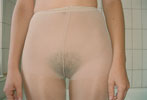
They bustled around, these women, with their mothers, with each other, and with their boyfriends. They decided, they staged, and they revealed.
They decided,
they staged,
and they revealed
When Mette Rask Pedersen received the assignment to make an interpretation of the cubist still life by Braque, “Grapes and Clarinet”, she kept the grapes, but replaced the clarinet with her breasts dipped in whipped cream.
Yummy cool satire.
The tone was raw, and there
was no holding back on
expressing powerlessness or hate
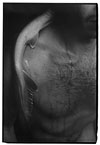
Marit Silsand placed a cold, wet, and limp porbeagle around her boyfriend’s neck. The emotions almost ran down his hairy chest.
Expressive and effective.
Andreas Nilsson was also expressive. Although the assignment was not about showing feelings, but about creating an image for the faithful, the church decoration he created, the apple’s round form, was all about articulating something he felt.
The apple smelled of desire. His contemporary interpretation of the creation story: From being a snake that entices the woman, to being a snake, that protects his woman, was visually unique. The age-old story got a modern twist. You should not allow a snake to entice your woman, but you should desire her even if she is lying in the middle of a snakepit.
The men could also be effective.
Your personality was not
expressed in what you
were capable of
what you dared to do,
or what you could come up with,
but rather in who you were
expressed in what you
were capable of
what you dared to do,
or what you could come up with,
but rather in who you were
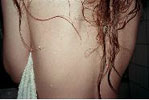
Jacob Hoeck, who had interrupted an apprenticeship with a photographer in Herning to attend Fatamorgana, never staged his images. He either found them, bumped into them, was attracted by them, and hung on to them. With simple expression he made photographic notes, wherever he went, and everything he chose to record, were visualizations of how he felt, never of what he saw.
People on the street became distant figures,
and the woman in his life, a warm body.
and the woman in his life, a warm body.
Excerpt, distance, framing and sharpness always described who he was and how he was feeling. What he had to photograph to describe how it looked, held no interest to him, and it was completely impossible for him to hide how he felt about what he was depicting.
People on the street became distant figures,
and the woman in his life, a warm body.
That is how Jacob was, shy with strangers, and loving to those closest to him.
After three semesters at Fatamorgana he was employed as a teacher at the Technical School, but they could not employ him on a permanent basis because he had left his apprenticeship with a commercial photographer and instead become a sensitive documentarian.
He has since then continued his sensitive style, and recently published the book “Detour”. He has fathered two boys with his girlfriend, my oldest daughter Amalie.
Kine Ravn got the students to dare,
Anders Pedersen got them to feel,
and JH Engström got them to
understate and be honest
From being eye catching and well formulated, argumentative and revealing, it now became a tool for intuition and inclination. The images were not to show emotions, but rather to be created by them. Your personality was not expressed in what you were capable of, what you dared to do, or what you could come up with, but rather in who you were.
The code word
was honesty
was honesty
Julia Ekström was such a intuitive and sensitive documentarist. At the age of 19 she had been declined a place at Fatamorgana, but she insisted and worked hard and was admitted the following year. She started full of ambition and energy, without any idea of where it might lead. The one thing she knew was that she wanted to be famous. Her father had gone to Christer Strömholm’s school together with Anders Pedersen almost 40 years earlier, and now she wanted to impress daddy.
She was good, but not as good as daddy would have liked. There were too many un-sharp and overly saturated images. Her mother was more enthusiastic. She offered herself up for Julia’s camera and intuition and soon Julia was in the midst of a portrait of her Mom.
One fantastic image followed the other. Her mothers torso marked by a breast operation, her party painted lips asleep under the duvet, in the arms of her husband, and on a walk with the dog. The trivial and daily became hyper interesting in Julia’s images.
She mixed Polaroid, and color snapshots with black and white elegance, medical recordings, and askew family album shots, with emotional un-sharp dreamy images. It was like a game. She invented a new documentary style: A technical mess that oozed of love, suspense, and the desire to communicate.
A technical mess that
oozed of love, suspense and
the desire to communicate
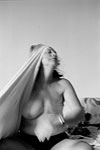
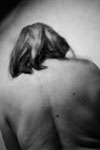
The images were not to show emotions,
but rather to be created by them
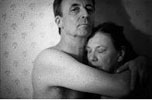
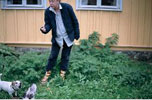

The code word was honesty. Documentary photography had a new look, but the goal remained the same; the virtue of honesty.
Kine Ravn got the students to dare, Anders Pedersen got them to feel, and JH Engström got them to understate and be honest.
Only when Julia wanted to decorate her images did I say no. When she wanted to design or arrange them, I stopped her.
Otherwise she had free reigns and created a fantastic series that won her a place at the The Royal Danish Academy of Art in Copenhagen.
And daddy thawed. He still cannot see the quality in what she creates, but he respects that others do.
The time of prohibition
was over
was over
At Fatamorgana, there had always existed certain underlying common rules, that nobody had decided, but that were always complied with in terms of what was art. It was a kind of prerequisite for the image. There were some things you just did not do: The forbidden image.
An image that was created on order, to sell a product, was inferior. The commercial image vs. the artistic image was in the eyes of the students equated to prostitution vs. love. To take on an order was always a risky affair. So when the students did commercial assignments to make money, it happened on the sly, and if it was discovered, the images were packed in with excuses and reservations. Nobody was to think that it was something they actually meant.
The commercial image was prohibited, as was the commercial look. Nobody dared play with the image-to-order’s aesthetic in fear of being stamped as dishonest and inferior.
But just as documentary photography at that time was in the turbulent process of rediscovering its original ideals and finding meaning and form, all of a sudden images were popping up that until then had been forbidden.
Vanna Envall struck a pose.
With a fashion model’s self-assured attitude she arranged herself in certain selected photographic places wearing fashion conscious clothes.
These were not caricatures, nor was it satire, or for fun images, this was fashion. Contemporary fashion. Fashion with style.
The images were not a protest, they were not about saying anything against or about doing anything dangerous or to provoke anyone. The images were a result of that time’s capacity to be large.
That was the beginning of the “why not?” period.
Where before the dividing line had been between reality and the arranged, the line was now drawn between honesty and “why not?”
Vanna posing in the lyme grass became the poster for that year’s exhibition. The students had evaluated, discussed, and chosen the image they saw as being the most suitable image.
And honestly, why not?
At Fatamorgana, there had always existed
certain underlying common rules, that
nobody had decided, but that were always
complied with in terms of what was art

Rebecka Möller’s sophisticated fashion images were not fully so forbidden. They contained a fair amount of self-irony and humor in their styled arrangements of super stylish women and men, looking as though they had been taken right out of a 1950’s French Vogue.
Rebecka had put a lot of focus on the scenography, casting, make-up and props and made the pictures authentic looking by photographing in the old-fashioned posed studio style.
The “Why Not?” period had given her courage to realize a dream, a dream of visualizing the idealized women of the past.
It was not just the forbidden fashion photographs that gained legality, there were several other just as forbidden genres that came to light as well. Illustrations, the graphic illustration, had been a minefield.
Our images were always to convey their own message, never to pass on someone else’s message. The word “stylized” was negative, and was an indication of a false alluring surface that lacked honesty.




Rune Bjørk Mandsbjerg managed a genre balancing-act. He could jump from one style to another, and he did. Multiplicity was a quality he possessed, and his visual talent and perseverance provided for success within many genres. His ambition was not to become more and more personal in his photography, but more and more versatile. It was not to close in on one specific genre, but to be able to choose the one that was best suited to what he wanted to express at the time.
The illustration was a tool he worked with, and his efforts in the graphic realm resulted in a series of fantastic ornaments with a crown of flowers as the underlying motif, and Photoshop as his tool.
If they had not been thorough in their execution, I would have thrown wallpaper samples at him, but they actually looked really good. The following day Rune had jumped to another genre and he never returned to ornament boutique again.
When a German erotica magazine showed interest in Olivia Frølich’s image of her friends lying half-dressed in a bed, and asked her if she would be interested in sending them what she had of erotic images, she did not say no.
She thought seriously about the inquiry, and after looking at her photos of her friends, and finding out what the magazine would pay, she said, “Why not?”
She flirted with the erotic and with fashion and had no qualms about selling her images. On the contrary, she shone with pride with the possibility of recognition and a profession.
The girly picture had been legalized as a genre, the naked or half undressed woman was allowed to satiate our erotic fantasies. The border between what was allowed and what was not, smoldered. The times of prohibition were over.
Also the glossy image, the impressive and commercially presentable image, which had always been treated with scorn and been belittled because of its substance-less visual deception, was now being re-evaluated and accepted.
Pomp and circumstance were no longer amoral, just because it was commercial, or had a commercial look.
Thomas Nørdam Andersen had been a freelance photographer and was an old hand, when it came to glossy commercial photographs. He could fix them so they came out as killer images. He was a master of glossy images.
And therefore also a master in images that lacked content and were boring. At Fatamorgana he wanted to further develop his gorgeous pictorial style, but he did a complete summersault, and instead ended up working with a sketch-like snapshot style that was personal and impulsive.
He never abandoned his admiration for the beautiful image. Even though he threw amazing and intensely experienced images on the table one after the other which he took at lightning pace. Even though he received lots of praise, he could not change his perception of what a real photograph looked like. The snapshot was too easy, too incomprehensible to the man in the street, and it was commercially inapplicable.
But his image of Mærsk Mc.Kinney Møller’s new work of splendor mirrored in the shiny surface of the water everyone could understand in its grandeur and opulence.
He had been given the assignment to create an image for the human rights paragraph “Everybody has the right to participate in society’s cultural life”, and could not withstand the temptation of making a magnificent commercial depiction of the new opera house. Afterwards he sold it to the shipping magnate. Why not?
But the commercial wave lost it’s power, and the “why not?” period soon breathed its last breath.
Curiosity and
personality were back
on the track
personality were back
on the track
The desire to acquire self-confidence in the existing market changed to the desire to acquire self-confidence in being original: In what had not been seen before. The world should not be handed what it wanted, but rather, what it needed and did not know it was in need of.
The documentarians searched, as they always had, for those in need, for the homeless and forlorn. They stayed at halfway houses, or asylum centers, and wandered around at night looking to catch a glimpse of a lawless graffiti artist, but these images had more of an aura of personal experiences than of information being recorded. The press photo was a dead herring, and the non-objective drifting in environments foreign to the photographer took over. We were not to be informed of something new, we were to be informed of something we already knew in a new way.
Personality and character were to carry the documentary images, and not the rarity of the motif.
Who am I that sees, who am I that creates, who am I that sets the stage?
Often the registering and informative
image was a lie, and the truth
was hidden in the staged image
Documentary photography’s role had changed, curiosity and personality were on the agenda again.
It had to be experienced, and it needed to be real.
But if reality needed a helping hand, nothing stood in the way of that.
Ann-Sophie Tranekær Fjellø-Jensen wanted to, after having photographed a homeless person and having hung out at a veterinary hospital, make a documentary series about her mother’s car, a red Fiat 600.
To photograph what it looked like was no problem, so Sofie decided to get into the car and sit for several hours to get to know it inside and out, while she photographed.
By the evening she felt so at home that she threw her legs out the window and took a nap. That’s the spirit. Here is a documentary photographer working seriously.
But it is the Director who arranges the camera on a tripod to share the experience.
We are to experience it, to feel how she feels. The experience is the truly personal experience. Find a place, inhabit it, and then, be present.
We were not to be informed of something
new, we were to be informed of
something, we already knew in a new way
Like in Ellinor Forsberg’s Lolita series. If she had photographed what was happening, our solidarity with the willing substitute for a woman would probably have drowned in contempt and condemnation.
But in the images Ellinor created, romantic everyday moments of a blow-up substitute, Lolita was given her own life, even in the double bed.

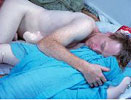
It is too easy to reject the series as mere fantasy. It is a psychological portrait of a user that goes deep.
Original, different, and eye-catching: There is no doubt of Lolita’s fate and Ellinor’s intention.
Then, it is a little more difficult with Trille Skelborg’s arrangement in a second grade way out in the boondocks.
Touching intimacy, and
laughter-provoking distance
laughter-provoking distance
She was supposed to make a paraphrase of Salvador Dali’s melting watches, and she took on the challenge by placing her grandmother and her girlfriends in a classroom decked out in wedding dresses.
Time had melted, time had become disarranged. But the deeper meaning we were left to ourselves to come up with.
It was an experience, it was original, the images ended up at Charlottenborg’s Spring Exhibition, along with one of her other fantasy filled adventures.
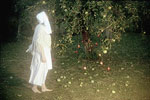
Mother Hulda, from a tale by the Grimm Brothers had been visualized in the same inventive and entertaining way.
The images were both touchingly intimate and laughter provokingly distant, and Trille enjoyed inventing and arranging, enjoyed her self-created journey to this new land.
Original,
different
and eye-catching
Armed with a plaster cast of a gun, and a video camera, she went with her mother to the grave of her father, where she tried to get her mother to ceremonially kill him again. She did not succeed.
Kirsten Thorup went along to the graveyard, but she would not come along to the land of experiences. She refused to be filmed or to shoot, even though it was a fake gun.
So Aia had to take the gun in her own hands, and the piece did not become the success she had hoped for.
The world should not be handed
what it wanted, but rather,
what it needed
what it wanted, but rather,
what it needed
But Esben Olesen had success. The starting point for his project was, to use a long exposure. This would allow for existing traffic to be erased, while his models, who were given specific roles, stood completely still.
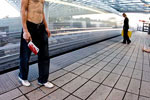
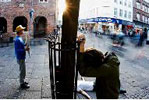
His visual riddles were not to be
understood, but to be experienced
In a series of dramatic street games he orbited around the theme of death. In some of the photographs the dead figure is lying under a white sheet, in others, he has just fallen over.
A cranium, a bloody butchers knife, and a noose, set our fantasy free.
His visual riddles were not to be understood, but to be experienced.
It was like crashing down in the middle of a thriller and to leave it again without knowing what had happened. A few seconds of deadly stillness in a world that was whizzing past.
Reality and staging went hand in hand, documentary photography and staging drifted together.
When Fryd Frydendahl was given the assignment to create a calendar image for the upcoming AIDS calendar, she went home to a couple with two pairs of handcuffs.
The picture she took is a document. Almost. The sun, the couch, the pictures on the wall, the hair on the guys chest, the photographer’s shadow, the open door, and the sad expressions. All of these elements are real and everyday like, all, except of course, for the handcuffs. With underplayed humor Fryd had chained the couple to each their end of the couch, and visualized the invisible problem. Brilliant.
Those handcuffs could be
a symbol of anything
She was good Fryd, good at making things up, and cutting through. She worked impulsively for intense periods. Used herself and her closest friends, was direct and insisting, and always extreme in her articulations.
Both her and Esben’s performances became more and more cryptic with time.
In the experiencing documentarism
you never knew what had happened,
and what had been created
Fryd’s aging schoolgirl with a bag full of Greenlandic shrimp was one of the last things she made before the “how do I feel” wave hit down like a tsunami.
When Bettina Pleidrup, Line Kallmayer , and Jacob Emdal started at the school in the spring of 2005 they were horrible photographers. They had no work method, socially they functioned badly, they could not talk about photography, and went their own ways. They were loners, originals, who did not trust the world, or believe in themselves.
But what they did have in them was a God given talent: An eye for images, and ambition.
For a long period the focus had been on how one might feel. Now what was important was how do I feel.
Jacob did everything I told him to, Line did the opposite, and Betina loved to hear what she should do, but forgot it all the minute she walked out of the door.
They did have in them
a God given talent.
An eye for images,
and ambition
Every time Betina had a tutorial, she laid out on the table all the images she had made since the first day. It was like starting over again every time. The projects theme was “The empty room”
The room could be something she saw, a place she found herself in, what the eyes saw while she was thinking about something else. Slowly but surely this room became filled with strange things, or ordinary things that looked strange.
She was periodically hyperactive, pictures flew around her like leaves in an autumn storm, other times her creativity blacked out and she lost her courage.
Line groped her way through images that were all about ambiance, and asked for advice, only when she had already made up her mind.
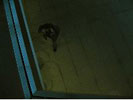


If I did not agree, she defended herself with claws and beak, and did not budge an inch.
Jacob saw me as a partner, we quickly figured out how to distribute the workload; he photographed, and I edited. This gave him peace whilst photographing, so he could focus on seeing and recording, and then I would take care of the rest.
It was the year of H.C. Andersen’s, celebrating his 200th birthday, and I had given the students the assignment; “What a fly can tell us…” and I urged them to be mobile, insisting, curious and to see the world with new eyes.


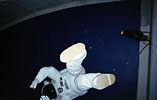
“ …In a personal account, story, or fairy tale, open our eyes to something we otherwise do not see.”
Jacob was elected Fatamaorgana’s H.C Andersen ambassador by the other students for the bizarre visual fable he created.
Towards the end of the threesome’s first semester, Line was accepted at Glasgow School of Art, Betina wanted to apply to The Royal Danish Academy of Art, and Jacob had not even considered what was going to happen beyond the summer.
But then Line decided against Glasgow and started a study group with Betina and Jacob with the goal of locating and getting into the best art school in the world.
The result was that Jacob went to study with Wolfgang Tillmans in Frankfurt, Line chose Goldsmiths in London, also having been accepted at the Gerrit Rietveld Academy in Amsterdam, and Betina was accepted at The Royal Danish Academy of Art in Copenhagen.
The worse it is,
the better
the better
The “how do I feel” period flowered, the worse you had it, the better it was. To have lost one’s mother in an accident, to be pregnant in the fifth month, to be one eighth Jewish, or a lesbian adoptee, borderline psychotic, or sadomasochistic: To have an issue made it all a little more interesting than if one was just plain satisfied or happy with the cards life had dealt you.
Or even worse, if one was just plain ordinary.
So there was nothing left for the ordinary ones to do than to go out in the world and find something interesting to photograph.
They went to the Masonic lodge, the fitness center, to the crematorium, to the army barracks, found homeless people in the street, and went home with a neo-Nazi. Valdemar Jørgensen was sent out on daily assignments to stimulate his hunting instinct and markmanship. His wish, like all the other normal ones, was to get into the Journalisthøjskolen in Århus to become a photojournalist.
When the photo’s from the first admission test that year to get admitted to Århus had been evaluated all the students from Fatamorgana had passed, Valdemar too.
But not Sofie.
Sofie Holten was ordinary, but not ordinary enough.
She had made reportages about the Police Academy, followed a group of cheerleaders, but her heart actually beat for the “how do I feel” image.
The disappointment of not going with all the others to Århus was soon turned into another kind of victory. She applied to and was accepted at the International Center for Photography in New York. It’s amazing what you can convince your parents to do, when you tell them you have been accepted at the best photography school in the world.
Her heart actually beat for
the how-do-I-feel-image
The year after she was accepted to The Royal Danish Academy of Art in Copenhagen with two videos she had made while at ICP.
No, Sofie was far from ordinary.
Flaming lovemaking
and bizarre symbolism
and bizarre symbolism
Ingvild Haugen Heimstad was not crazy, and had no traumas. She was a sweet, uncomplicated, and ordinary girl, but she had an amazing drive: She loved to make pictures. She was always smiling, and humming, and was always in the middle of something important.
And then she had the great advantage of having no idea of what she was doing.
Her images were original, brutal
and raw. And they oozed of desire
Her time at the school became a long recess with strong colors, mysterious masks, peculiar attitudes, cheeky angles, disrespectful flash, flaming lovemaking and bizarre symbolism.
Her images were original, brutal and raw. And they oozed of desire.
This is how things are,
what do you want to do about it?
what do you want to do about it?
Kasper Oppen Samuelsen, who was a rigorous and designing schemer, had a horrible month trying to do outreach documentarism. Then he found his very own photographic niche, the creative collage.
Everything became like a game, he was abuzz with ideas, and he moved his pieces around until they fell into place to make his statement: These are the facts of the matter, what do you want to do about it?

He placed his pieces strategically in his colorful fantasy game and encouraged us to make the next move.
Marie Louise Siim did the same thing. She presented us with the pieces in her game; This is how things are, what do you want to do about it? Then she waited for us to make the next move, to point out the sinner.
She had been allowed to reconstruct a police line-up of her male fellow students at the local police station. Who is the guilty one? Choose a number.
The image arrived at high speed and cause a big debate. Disrespectful, provoking, and loud, it trampled over the remains of the sensitive period and alerted us of a new, more direct, period to come.
The door was opened to
the paradise of spectacles
the paradise of spectacles
“You have just landed, you are on foot, you have never been here before” I wrote for an assignment that was to be shown at Copenhagen City Hall which was to function as a contribution to a debate around the subject CPH as a Metropolis.
Allan Birkegaard Hansted took the assignment seriously and knew exactly what a lonely businessman would want, having just arrived to the capital. A prostituted junky.

His image of a prostitute was just as raw and exposing, just as glaring and debate inciting as Ditte Haarlev’s images of AIDS infected drug addicts eight years earlier. That is what it looks like when one’s dignity is for sale.
I used the image as an eye catcher for the exhibition, because it placed focus on a side of being a Metropolis that should be debated, what do we do with dignity, when foreigners get horny?
The image brought forth condemnation, not because it was showing a subject people could not tolerate, but because the photographer went into his role and came to appear as the one who took the woman’s dignity away from her.
Allen was shaken, when I praised him as a photographer of sensations. His self-image cracked.
But it was a sensation, it was the first image in a new era where the mobile phone is a camera, and everyone is a photographer.
The door was opened to the paradise of spectacles, a place where torture is revealed, and terror, perpetuated. Where no speeding driver can feel safe, and where happy-slapping is an everyday occurrence.
Allan had just been acting professional. The woman was paid, and the image was staged.
No means were too strong, and all tricks were valid. Here it is Max Adolfsson who has been to the dentist to create debate around women’s true nature. Is she beautiful and seductive, or just an anatomical configuration.
Sun Hee Engelstoft was not as uncompromising in her militarily arranged nude of two women in an empty room.
But she brings up the same issue: What is woman? A being or a configuration? Body or soul?
The role of the woman was up for debate, and one of the sharpest to tackle the subject was Elizabeth Higson. She made a video, where an ambitious and beautiful woman seduces her prince, then stabs him to death in the duvet, when she has gotten what she wants.
When Bibi Berge coaxes Elizabeth down into the Metro, it is to have her act lonely and frustrated.
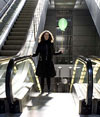
No means were
too strong, and all
tricks were valid
Anders Malmberg gave his male model a visual jaw-breaker so the blood flew. Cause that’s what men do.
Tobias Zehntner also made videos, fantastic videos about his experiences with role-play and indoor skiing competitions.
The portrait of the misplaced autonomous young man, who cannot get rid of his cobblestone, was taken for a poster assignment on the occasion of the clearing of The Youth House on Jagtvej.
It was an answer to the assignment “The association Friends of the Youth House has decided to ask nine young and creative photographers to come with suggestions for posters to campaign for a new youth house in place of the one being torn down.”
Images and
statement
statement
The text on the poster was: Where shall we now be?
Yes, where are we headed?
The waves of debate with their biased eye catching images will drift out, and a new period will come surging in. Future students will make new inroads. It does not matter if a specific period returns, that it has already existed at the school. It will probably benefit from gathering strength to again emerge to help keep art alive at Fatamorgana.
Nadim Carlsen has just started at the Film School as a film-photographer, but before he left Fatamorgana, he may well, with one of his images, have shown the way for a new direction in documentary photography.
The image of the young second generation immigrant at the bowling alley is outstanding because it is so simple, concentrated, and yet, filled with contrasts.
A coarsely grained, un-sharp head, which is lit up, and fine, sharply focused, bristling fingers on the same individual. That is how things are at this moment, for immigrants, and such is the fate of the human always.
An, at the same time simple yet complicated image, current and timeless, both humanistic and political, and in line with the documentary tradition.
And for the directors there is also a possible road ahead. There is so much juiciness and power in Christina Glob’s fantastic salute: the topless woman on her way out of the ring at the end of the show. I believe the image will lead to a stream of satirical, political, and uninhibited statements.
Pink bows, and a grass green carpet; that is how the stage is set right now, and that is how life is, always.
Another period at Fatamorgana filled with images and statements. A time filled with stories about being capable human beings, and a confirmation that life should be lived while we’ve got it.
mb 24/08/2007
